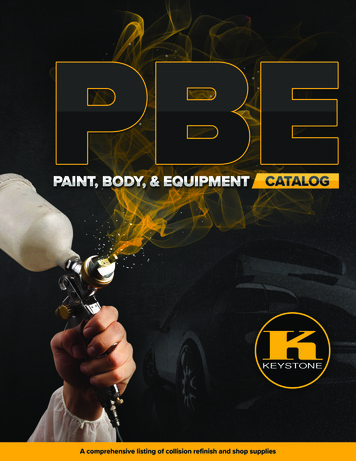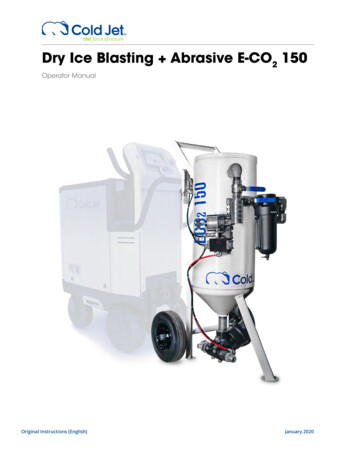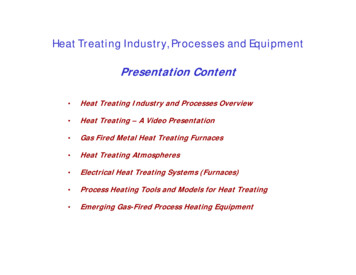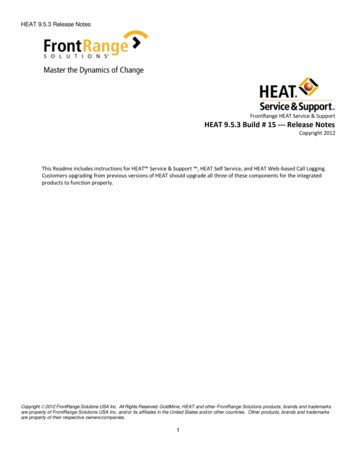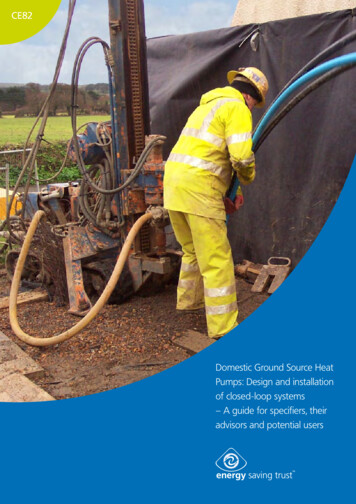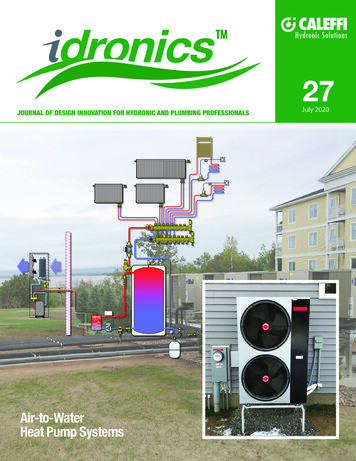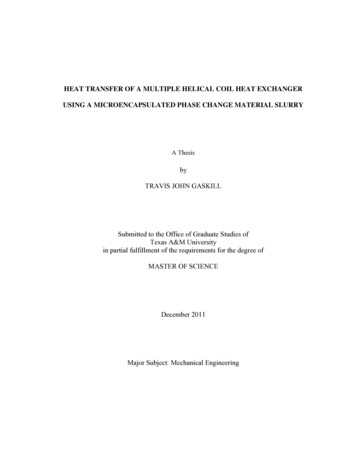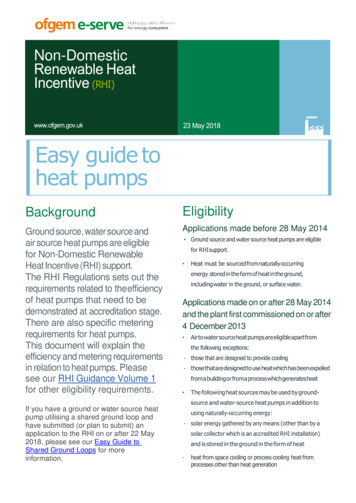
Transcription
Technical Report No. 3 (Revised 2013)Validation of Dry Heat Processes Usedfor Depyrogenation and SterilizationBethesda Towers4350 East West HighwaySuite 200www.pda.org/bookstoreBethesda, MD 20814 USATel: 1 (301) 656-5900
PDA Validation of Dry Heat Processes Used for Depyrogenation andSterilization Technical Report TeamAuthorsDeborah A. Havlik, Hospira, Inc., Technical ReportTeam LeaderBruce Bear, Bear Consulting ServicesStewart M. Davenport, Pfizer, Inc.Mike Davies, Lonza Biologics, UKSteve B. Folio, Althea TechnologiesJill K. Giulianelli, West-Ward PharmaceuticalsBrian G. Jordan, Valsource, LLCPeter S. Lee, Mattell Inc.Hans Melgaard, Despatch IndustriesChristian G. Supina, Baxter Healthcare CorporationRita Welser, Boehringer Ingelheim, GermanyRobyn F. Wong, Celgene CorporationContributorJames F. Cooper, ConsultantDisclaimer: The content and views expressed in this Technical Report are the result of a consensus achieved by theTechnical Report Team and are not necessarily views of the organizations they represent.www.pda.org/bookstore
Validation of Dry HeatProcesses Used forDepyrogenation andSterilizationTechnical Report No. 3 (Revised 2013)ISBN: 978-0-939459-56-8 2013 Parenteral Drug Association, Inc.All rights reserved.Bethesda Towers4350 East West HighwaySuite 200Bethesda, MD 20814 USATel: 1 (301) 656-5900Fax: 1 (301) 986-0296E-mail: info@pda.orgWeb site: www.pda.orgwww.pda.org/bookstore
Table of Contents1.0 INTRODUCTION.16.0 PROCESS DEVELOPMENT.201.1 Purpose and Scope . 16.1 Process Design Approaches . 206.1.1 Overkill Design Approach. 206.1.2 Product Specific Design Approach . 216.2 Defining Operating Parameters . 216.3 Batch Oven Process Development . 216.3.1 Developing Loading Patterns. 216.3.2 Loaded Batch Oven TemperatureDistribution Studies . 226.3.3 Loaded Batch Oven HeatPenetration Studies . 226.4 Continuous Convection TunnelProcess Development. 236.4.1 Developing Loading Patterns –Continuous Tunnels. 246.4.2 Loaded Tunnel Temperature Distribution .246.4.3 Loaded Tunnel Heat Penetration Studies .252.0 GLOSSARY OF TERMS.23.0 THE SCIENCE OF DRY HEAT DEPYROGENATIONAND STERILIZATION.63.1 Depyrogenation . 63.2 Endotoxin Indicators. 73.2.1 Preparation and Inoculation. 73.2.2 Sample Processing. 73.2.3 Recovery. 83.2.4 Results Interpretation/Endotoxin LogReduction Calculations. 83.2.5 Glassware Depyrogenation . 83.2.6 FH–value for Depyrogenation . 93.3 Sterilization . 93.3.1 Mechanisms of Inactivation . 93.3.1.1 FH-Value for Sterilization . 103.3.1.2 D-value and z–value. 113.3.2 Biological Indicators. 113.3.2.1 Biological IndicatorSelection and Type of Carrier. 114.0 EQUIPMENT DESIGN.134.1 User Requirements Specification . 134.1.1 High-efficiency Particulate Air or UltralowParticulate Air Filters . 134.1.2 Batch Convection Oven. 144.1.3 Continuous Convection Tunnel. 155.0 EQUIPMENT QUALIFICATION.175.1 Environmental Qualification . 185.2 Uniformity of Heating Media . 185.3 Empty Chamber Temperature Distribution(Ovens and Tunnels). 197.0 PERFORMANCE QUALIFICATION.277.1 Physical Qualification. 277.2 Biological Qualification . 277.2.1 Biological Indicator Testing . 277.2.2 Endotoxin Indicator Testing . 287.3 Process Equivalency . 288.1 Routine Release . 298.2 Preventive Maintenance . 298.0 ONGOING PROCESS CONTROL.298.3 Change Control / Revalidation. 308.4 Periodic Requalification of Equipment. 308.5 Parametric Release . 309.0 REFERENCES.32FIGURES AND TABLES INDEXFigure 4.1.2-1 Example of Batch Convection OvenShowing Airflow. 15Figure 4.1.3-1 Continuous Convection Tunnel. 16Table 5.0-1 Example of EquipmentQualification Checklist. 17Figure 6.3.3-1 Load Profile–Batch Oven. 23Figure 6.4.3-1 Glass Vial Load Heat PenetrationProfile–Continuous Convection Oven.26www.pda.org/bookstore
1.0 IntroductionThis technical report is an update of PDA’s Technical Report No. 3, Validation of Dry Heat Processes usedfor Sterilization and Depyrogenation which was issued in 1981. The technical report focuses on the microbiology and engineering qualification of dry-heat sterilization and depyrogenation processes and thegeneral approach to sterilization and depyrogenation science in batch and continuous sterilizers (ovensand tunnels). This technical report is based on standard depyrogenation and sterilization science.The primary objective of the Technical Report Team was to develop a scientific technical reporton dry-heat depyrogenation and sterilization processes that provides recommendations for use byindustry and regulators. References to appropriate and current scientific publications, internationalregulatory documents, journal articles, technical papers and books are used where more detail andsupportive data can be found.The Technical Report Team is composed of diverse international team of professionals to ensure themethods, terminology and practices of dry-heat depyrogenation and sterilization processes reflectsound science and can be used globally. This technical report was disseminated in draft for public review and comment prior to publication to ensure its suitability as a recommendation of best practicesto industry.1.1 Purpose and ScopeThis technical report provides information to the manufacturers of pharmaceutical products for validating dry-heat depyrogenation and sterilization processes. The concepts and methods presentedwithin this technical report are not intended to be a regulatory standard, but rather as points to beconsidered during the validation of dry-heat processes. Other technically equivalent methods mayexist and may be used if they can be supported by sound scientific methods.This technical report is intended to give information about current industry practices and approachesto validating dry-heat depyrogenation and sterilization processes. In addition, sections will cover various aspects of dry-heat sterilization using biological indicators.This technical report is organized in a chronological fashion, starting with a discussion of the generalconcepts of depyrogenation and sterilization science which are the foundation upon which to builda robust process. This includes use of biological indicators and endotoxin indicators. Also includedare points to consider in equipment design, equipment verification, process development and performance qualification for new systems and the development and validation of processes for existingsystems.In the discussion of process development, particular attention has been given to the load type, loading patterns, and temperature profiles for depyrogenation and sterilization in both ovens and tunnels.The sections are followed by a brief discussion of items for consideration during routine processingand ongoing maintenance of the validated process.The background sections on depyrogenation/sterilization science and endotoxin/biological indicators are not comprehensive—but provide information specific to dry-heat processes. Informationwithin the technical report is applicable to both forced hot air dry-heat batch processes (chambers)and to continuous processes (tunnels). Information within this technical report does not apply to dryheat processes used for the sterilization of oil bases and oil based products, fixed processing streamsor to those processes using infrared and microwave heating media.Technical Report No. 3 (Revised 2013) www.pda.org/bookstore 2013 Parenteral Drug Association, Inc.1
regulatory documents, journal articles, technical papers and books are used where more detail and supportive data can be found. The Technical Report Team is composed of diverse international team of professionals to ensure the . methods, terminology and practices of dry-heat depyrogenation and sterilization processes reflect



